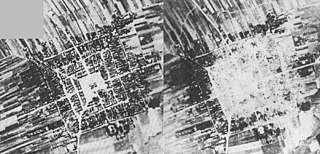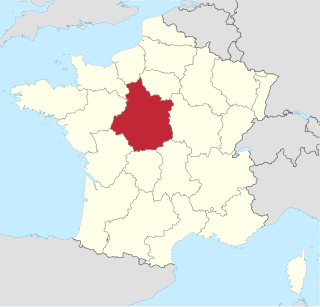
The Luftwaffe was the aerial-warfare branch of the Wehrmacht before and during World War II. Germany's military air arms during World War I, the Luftstreitkräfte of the Imperial Army and the Marine-Fliegerabteilung of the Imperial Navy, had been disbanded in May 1920 in accordance with the terms of the 1919 Treaty of Versailles, which banned Germany from having any air force.

The Home Army was the dominant resistance movement in German-occupied Poland during World War II. The Home Army was formed in February 1942 from the earlier Związek Walki Zbrojnej established in the aftermath of the German and Soviet invasions in September 1939. Over the next two years, the Home Army absorbed most of the other Polish partisans and underground forces. Its allegiance was to the Polish government-in-exile in London, and it constituted the armed wing of what came to be known as the Polish Underground State. Estimates of the Home Army's 1944 strength range between 200,000 and 600,000. The latter number made the Home Army not only Poland's largest underground resistance movement but, along with Soviet and Yugoslav partisans, one of Europe's largest World War II underground movements.

The Invasion of Poland, also known as the September Campaign, Polish Campaign, and Polish Defensive War of 1939, was a joint attack on the Republic of Poland by Nazi Germany, the Slovak Republic, and the Soviet Union, which marked the beginning of World War II. The German invasion began on 1 September 1939, one week after the signing of the Molotov–Ribbentrop Pact between Germany and the Soviet Union, and one day after the Supreme Soviet of the Soviet Union had approved the pact. One of the aims of the invasion was to divide Polish territory at the end of the operation; Poland was to cease to exist as a country and all Poles were to be exterminated. The Soviets invaded Poland on 17 September. The campaign ended on 6 October with Germany and the Soviet Union dividing and annexing the whole of Poland under the terms of the German–Soviet Frontier Treaty. The invasion is also known in Poland as the September campaign or 1939 defensive war and known in Germany as the Poland campaign.

The Warsaw Uprising, sometimes referred to as the August Uprising, was a major World War II operation by the Polish underground resistance to liberate Warsaw from German occupation. It occurred in the summer of 1944, and it was led by the Polish resistance Home Army. The uprising was timed to coincide with the retreat of the German forces from Poland ahead of the Soviet advance. While approaching the eastern suburbs of the city, the Red Army halted combat operations, enabling the Germans to regroup and defeat the Polish resistance and to destroy the city in retaliation. The Uprising was fought for 63 days with little outside support. It was the single largest military effort taken by any European resistance movement during World War II. The defeat of the uprising and suppression of the Home Army enabled the pro-Soviet Polish administration, instead of the Polish government-in-exile based in London, to take control of Poland afterwards. Poland would remain as part of the Soviet-aligned Eastern Bloc throughout the Cold War until 1989.

World War II (1939–1945) involved sustained strategic bombing of railways, harbours, cities, workers' and civilian housing, and industrial districts in enemy territory. Strategic bombing as a military strategy is distinct both from close air support of ground forces and from tactical air power. During World War II, many military strategists of air power believed that air forces could win major victories by attacking industrial and political infrastructure, rather than purely military targets. Strategic bombing often involved bombing areas inhabited by civilians, and some campaigns were deliberately designed to target civilian populations in order to terrorize them and disrupt their usual activities. International law at the outset of World War II did not specifically forbid the aerial bombardment of cities – despite the prior occurrence of such bombing during World War I (1914–1918), the Spanish Civil War (1936–1939), and the Second Sino-Japanese War (1937–1945).

The siege of Warsaw in 1939 was fought between the Polish Warsaw Army garrisoned and entrenched in Warsaw and the invading German Army.

The Warsaw Ghetto Uprising was the 1943 act of Jewish resistance in the Warsaw Ghetto in German-occupied Poland during World War II to oppose Nazi Germany's final effort to transport the remaining ghetto population to the gas chambers of the Majdanek and Treblinka extermination camps.

The Warsaw Uprising began with simultaneous coordinated attacks at 17:00 hours on August 1, 1944 (W-hour). The uprising was intended to last a few days until Soviet forces arrived; however, this never happened, and the Polish forces had to fight almost without any outside assistance. Initially the battle raged throughout most of Warsaw, but after a short time it became confined to districts in the West of the town. The key factor in the battle was the massive imbalance of weapons between the two sides. The German side was extremely well equipped whilst the Polish side had, initially, barely enough ammunition for a few days. The policy of one bullet, one German allowed the Polish fighters to sustain the uprising for many weeks at the cost of their own lives. Some areas fought for a full 63 days before an agreed capitulation took place. The losses on the Polish side amounted to 18,000 soldiers killed, 25,000 wounded and over 250,000 civilians killed; those on the German side amounted to over 17,000 soldiers killed and 9,000 wounded.

In the German language, Festung Warschau is the term used to refer to a fortified and well-defended Warsaw. In the 20th century, the term was in use on three occasions during World War I and World War II. It was used when the Germans threw back the Russian advance in 1914, where Warsaw came within distance of the fighting in October. The term resurfaced during the September 1939 German invasion of Poland. Later in the second war, the term resurfaced between September 1944 and January 1945, when the retreating Germans tried to establish a defense in the city against the advancing Soviet Union.

The Battle of the Bzura was both the largest battle and Polish counter-attack of the German invasion of Poland and was fought from 9 to 19 September. The battle took place west of Warsaw, near the Bzura River. It began as a Polish counter-offensive, which gained initial success, but the Germans outflanked the Polish forces with a concentrated counter-attack. That weakened Polish forces and the Poznań and Pomorze Armies were destroyed. Western Poland was now under German occupation. The battle has been described as "the bloodiest and most bitter battle of the entire Polish campaign". Winston Churchill called the battle an "ever-glorious struggle".

The bombing of Warsaw in World War II started with the aerial bombing campaign of Warsaw by the German Luftwaffe during the siege of Warsaw in the invasion of Poland in 1939. It also included German bombing raids during the Warsaw Uprising in 1944. During the course of the war, approximately 85% of the city was destroyed due to German mass bombings, heavy artillery fire, and a planned demolition campaign.

The Bombing of Frampol occurred during the German invasion of Poland in 1939. On 13 September, the town of Frampol with a population of 4,000 was bombed by the German bombers of Luftwaffe's 8th Air Corps, under General Wolfram Freiherr von Richthofen. The town had no military value, and the bombing was seen as a practice run for future missions.

In Poland, the resistance movement during World War II was led by the Home Army. The Polish resistance is notable among others for disrupting German supply lines to the Eastern Front, and providing intelligence reports to the British intelligence agencies. It was a part of the Polish Underground State.

The siege of Odessa, known to the Soviets as the defence of Odessa, lasted from 8 August until 16 October 1941, during the early phase of Operation Barbarossa, the Axis invasion of the Soviet Union during World War II.
During the Second World War the German Luftwaffe was the main support weapon of the German Army (Heer). It fought and supported the Wehrmacht's war effort throughout the six years of conflict and contributed to much of Nazi Germany's early successes in 1939–1942. After the turn in Germany's fortunes, it continued to support the German ground forces until the German surrender in May 1945.

Chartres – Champhol Aerodrome is an airport serving Chartres and Champhol, in the Eure-et-Loir department in north-central France. The airport is located 2.5 km (1.3 NM) east-northeast of Chartres and it is southeast of Champhol. It supports general aviation with no commercial airline service scheduled.

The Fallschirmjäger were the airborne forces branch of the Luftwaffe before and during World War II. They were the first paratroopers to be committed in large-scale airborne operations. They were commanded by Kurt Student, the Luftwaffe's second-in-command.

Wawrzyszew is a neighbourhood, and a City Information System area, in Warsaw, Poland, located within the district of Bielany.

Chomiczówka is a neighbourhood, and a City Information System area, in Warsaw, Poland, located within the district of Bielany.

The Suppression of Wawrzyszew was a pacification operation during the Second World War, enacted by German forces on the population of the village of Wawrzyszew. It took place on 3 August 1944, during the Warsaw Uprising, and as part of it, 30 inhabitants of the village were killed, the buildings set on fire, and remaining population displaced.


















